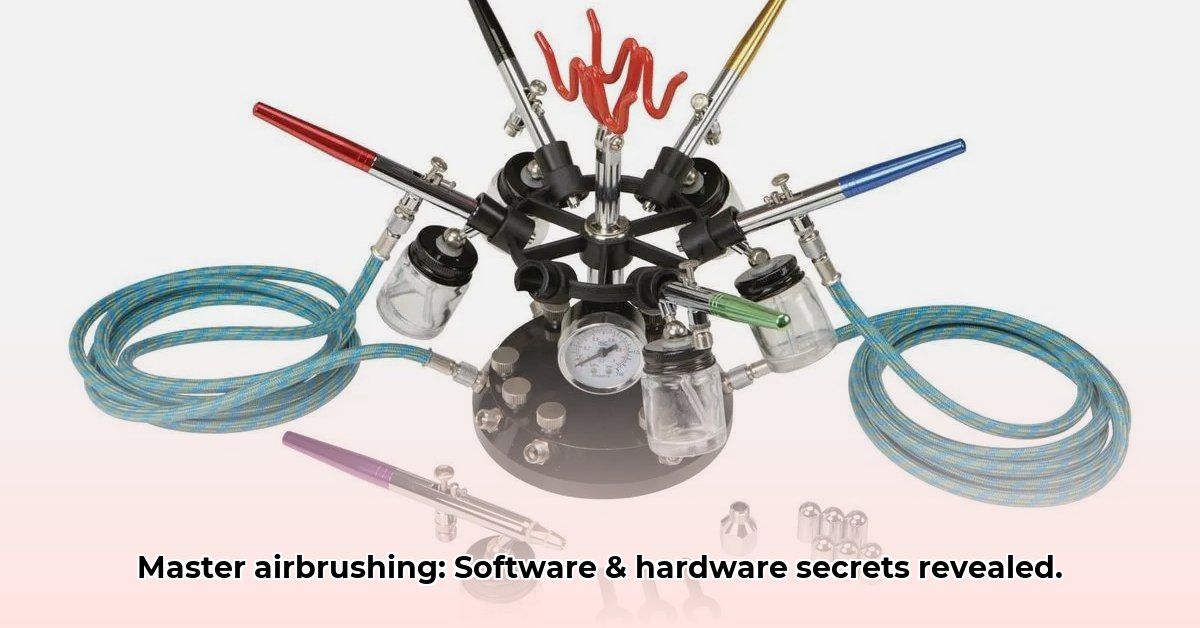
Airbrush Mastery: A Comprehensive Guide
Aspiring to become a professional airbrush artist? This guide provides a comprehensive overview of the software and hardware required for success, blending technical details with practical advice to guide you from beginner to expert. We'll explore the digital and physical aspects of airbrushing, highlighting the synergistic power of combining both. Are you ready to transform your artistic vision into stunning reality?
The Digital Canvas: Airbrush Software
Digital airbrushing software, such as AirBrush, offers a powerful entry point into the world of airbrushing. Imagine photo editing with the artistic freedom of an airbrush—that's the essence of these programs. User-friendly interfaces make them accessible to beginners, while advanced features cater to seasoned professionals. Subscription models often provide access to ongoing updates and new tools. Many programs even incorporate AI features, such as automatic skin smoothing, streamlining the editing process.
However, it's important to recognize that software, while highly beneficial, doesn't replace artistic skill. It serves as a valuable tool for learning foundational techniques, making quick edits, and enhancing existing artwork. Think of it as a powerful brush in your digital toolkit – a significant asset, but not a substitute for genuine artistic talent. What percentage of your workflow do you think should incorporate digital tools for optimal results?
The Tangible Touch: Mastering Airbrush Hardware
The heart of airbrushing lies in the hardware. This is where your artistic vision takes physical form. Companies like Master Airbrush offer complete systems including airbrushes, compressors, and paints, providing a convenient starting point. For larger projects, an HVLP (High-Volume, Low-Pressure) spray gun offers superior control and even paint application. A high-quality airbrush is akin to a precision instrument, responding directly to your touch for exquisite detail and versatility.
The choice of hardware directly impacts the final result. Intricate details call for a smaller, detail-oriented airbrush. Large-scale projects demand a larger gun. It's an investment, but a good airbrush will last for years, directly impacting the quality of your work. How crucial is investing in high-quality hardware when beginning your airbrushing journey?
The Synergistic Power: Integrating Digital and Physical
The modern airbrush artist seamlessly blends digital and physical processes. Many artists utilize digital tools for initial sketching and color correction before transferring the design to a physical canvas for final airbrushing. This combined approach unlocks a world of creative possibilities.
The future of airbrushing promises even more sophisticated AI integration, potentially offering real-time pressure adjustments based on digital designs or AI-powered color matching to enhance efficiency. This dynamic interplay between digital precision and tactile control makes for a powerful and flexible workflow. How do you envision the future of airbrushing technology shaping your creative process?
Software vs. Hardware: A Comparative Overview
| Feature | Software (e.g., AirBrush) | Hardware (e.g., Master Airbrush) |
|---|---|---|
| Ease of Use | High; intuitive interface, rapid learning curve | Moderate; requires practice and precise hand-eye coordination |
| Upfront Cost | Low; often subscription-based | High; significant investment for a complete setup |
| Precision & Control | Moderate; limited by software & screen resolution | High; allows exquisite detail and control over paint flow |
| Versatility | Primarily digital art & photo editing | Wide; fine art, automotive painting, apparel customization, etc. |
| Learning Curve | Short | Longer; requires dedicated practice |
Your Airbrushing Success: A Step-by-Step Guide
- Master the Fundamentals: Begin with core airbrushing techniques. Practice until hand-eye coordination becomes natural.
- Invest Wisely: Invest in high-quality tools, balancing cost with long-term value.
- Embrace Technology: Explore digital tools to refine workflow and enhance creativity.
- Build a Portfolio: Showcase your best work online and in person to attract clients.
- Network: Connect with other artists and professionals for collaboration and opportunities.
- Market Yourself: Establish a strong online presence (website, social media) to garner attention.
Integrating Airbrush Software & Hardware: A Seamless Workflow
"The key to success lies in the smooth integration of software and hardware," says Dr. Anya Sharma, Professor of Digital Art at the Institute of Creative Technologies. "Understanding the interplay between the two is crucial for maximizing creative potential and efficiency."
Choosing Your Airbrush Hardware
Selecting the right hardware is critical. Consider factors such as compressor type and power, airbrush type (single-action, double-action, gravity-fed, siphon-feed), paint cup size, and ergonomic design. A powerful, quiet compressor ensures consistent air pressure. The airbrush should feel like an extension of your hand.
Software Selection: Beyond the Basics
The software market offers a vast array of choices. Prioritize compatibility with your operating system and hardware, ease of use, and the availability of advanced features. Consider the software’s capabilities compared to your specific needs and artistic style.
Integrating Software & Hardware: A Step-by-Step Approach
- Compatibility Check: Confirm compatibility between software and hardware.
- Driver Installation: Install necessary drivers for your equipment.
- Software Setup: Install and configure the airbrush software following provided tutorials.
- Calibration: Calibrate the software and hardware for optimal responsiveness.
- Testing & Tweaking: Test the integration with a simple project, adjusting settings as needed.
- Workflow Optimization: Design your workflow for efficiency and comfort.
Advanced Techniques & Troubleshooting
Mastering advanced techniques, such as using pressure-sensitive tablets, enhances control. Troubleshooting may involve addressing software bugs, hardware malfunctions, or compatibility issues. Online communities and workshops prove invaluable resources. Remember, the journey of perfecting the integration of software and hardware is ongoing; continuous learning and experimentation are key.
⭐⭐⭐⭐☆ (4.8)
Download via Link 1
Download via Link 2
Last updated: Thursday, June 05, 2025